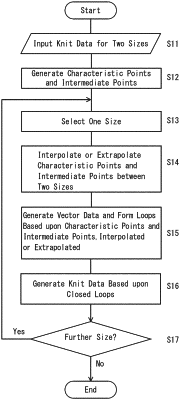| CPC D04B 35/00 (2013.01) [A43B 23/025 (2013.01); D04B 37/02 (2013.01); D10B 2501/043 (2013.01)] | 4 Claims |

|
1. A grading method for original knitted products, utilizing a grading system programmed and configured to generate knit data of a plurality of knitted products mutually different in sizes thereof, for driving knitting machines by the desired knit data of desired sizes for resized knitted products of a common design from a combination of initial knit data of two sizes of original knitted products, wherein knitting machines are driven by the desired knit data, wherein the method comprises the following steps performed by the grading system:
a: converting pattern data of the two sizes of the original knitted products to be graded to the combination of initial knit data;
b: modifying the the combination of initial knit data based on test knitting and/or computer simulations of the original knitted products to modified knit data;
c: generating characteristic points specifying shapes of the original knitted products regarding the modified knit data for said two sizes, automatically or interactively based upon a user's inputs, wherein the characteristic points specify characteristics of the modified knit data;
d: generating intermediate shapes specifying the shapes of the original knitted products between the characteristic points, automatically or interactively based upon the user's inputs;
e: interpolating or extrapolating the characteristic points and the intermediate shapes according to the desired sizes of the resized knitted products so as to generate characteristic points and intermediate shapes for the desired sizes;
f: generating closed loops by connecting the characteristic points and the intermediate shapes for the desired sizes; and
g: generating the desired knit data for the desired sizes so as to allocate knitted stitches within patterns specified by the closed loops.
|